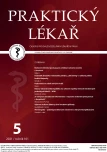Selected risk factors for stroke
Authors:
A. Hudáčková; L. Šedová; S. Bártlová; F. Dolák; L. Havierniková
Authors‘ workplace:
Ředitelka: prof. PhDr. Valérie Tóthová, Ph. D.
; Zdravotně sociální fakulta
; Ústav ošetřovatelství, porodní asistence a neodkladné péče
; Jihočeská univerzita v Českých Budějovicích
Published in:
Prakt. Lék. 2021; 101(5): 273-281
Category:
Of different specialties
Overview
Background. Strokes are one of the major diseases of a global medical and economic problem. Despite the fact that mortality is decreasing in the Czech Republic, their incidence remains high.
Goals. The aim of the research was to focus on the issue of comprehensive prevention of ischemic stroke and to evaluate the occurrence of selected risk factors of strokes among citizens in the Czech Republic.
Methods. A combination of a non-standardized questionnaire of stroke prevention and a standardized overall health literacy questionnaire (HLSQ – 16) was used to collect data. The field survey was conducted using the technique of a standardized controlled interview between the interviewer and the respondent. The sample was constructed as a quota and consisted of 1004 respondents. Statistical data processing was performed by SASD 1.4.12 and SPSS.
Results. 16.7% of respondents smoke tobacco daily, less often than 9.2% per day. The remaining citizens (74.1%) do not smoke. A statistically significant relationship was identified between tobacco smoking and gender, age, marital status, employment and education of citizens. 2.5% of respondents smoke e-cigarettes daily. 93.0% of citizens do not smoke. Whether or not a citizen smokes is significantly affected by age, marital status and employment. 6.0% of respondents consume alcohol every day or almost every day, 0.8% of abstainers. Alcohol consumption is significantly affected by the sex and age of the respondent, his marital status, employment and education. Factors that represent the greatest psychological burden include time pressure and the fact that work is so demanding that it cannot be done for years with the same performance.
Conclusion. It is important to improve the health literacy of the population in the issue of modifiable risk factors of strokes.
Keywords:
stroke – smoking – Alcohol consumption – risk factors – work mental stress
Sources
1. Bryndziar T, Šedová P, Mikulík, R. Incidence cévní mozkové příhody v Evropě – systematická review. Cesk Slov Neurol N 2017; 80/113(2): 180–189.
2. Calvet D. Ischemic stroke in the young adult/.Infarctus cérébral du sujet jeune. Rev Med Interne 2016; 37(1): 19–24.
3. Češka R, a kol. Interna. 2. aktualizované vydání. Praha: Triton, 2015.
4. Der-Shin K. Overwork, stroke, and karoshi-death from overwork. Acta Neurol Taiwan 2012; 21(2): 54–59.
5. Fadel M, Sembajwe G, Gagliardi, et al. Association between reported long working hours and history of stroke in the CONSTANCES Cohort. Stroke 2019; 50 : 1879–1882.
6. Hajek P, Phillips-Waller A, Przulj D, et al. A randomized trial of e-cigarettes versus nicotine-replacement therapy. N Engl J Med 2019; 380(7): 629–637.
7. Huаng Y, Xu S, Huа J. Аssociаtion between job strаin аnd risk of incident stroke: а metа-аnаlysis. Neurology 2015; 85(19): 1648–1654.
8. IKTA.CZ. Cévní mozková příhoda – iktus [online]. Dostupné z: https://www.ikta.cz/index.php?pg=home-cevni-mozkova-prihoda - iktus [cit. 2021-03-05].
9. Jood K, Karlsson N, Medin J, et al. The psychosocial work environment is associated with risk of stroke at working age. Scand J Work Environ Health 2017; 43(4): 367–374.
10. Kadlecová P, Andel R, Mikulík R, et al. Alcohol consumption at midlife and risk of stroke during 43 years of follow-up: cohort and twin analyses. Stroke 2015; 46(3): 627–633.
11. Kára T, Souček M. Chronická stresová zátěž, srdeční frekvence a esenciální hypertenze [online]. Dostupný z: https://www.medicinapropraxi. cz/pdfs/med/2004/01/03.pdf [cit. 2021-03-05].
12. Kivimäki M, Jokela M, Nyberg ST, et al. Long working hours and risk of coronary heart disease and stroke: a systematic review and meta-analysis of published and unpublished data for 603,838 individuals. Lancet 2015; 386(10005): 1739–1746.
13. Pérez-Piñar M, Ayerbe L, González E, et al. Anxiety disorders and risk of stroke: A systematic review and meta-analysis. Eur Psychiatry 2017; 41(1): 102–108.
14. Peters SA, Huxley RR, Woodward M. Smoking as a risk factor for stroke in women compared with men: a systematic review and meta-analysis of 81 cohorts, including 3,980,359 individuals and 42,401 strokes. Stroke 2013; 44(10): 2821–2828.
15. Toivanen S. Social determinants of stroke as related to stress at work among working women: a literature review. Stroke Res Treat 2012; 2012 : 873678.
16. Tsutsumi A., Kayaba K., Ishikawa S. Impact of occupational stress on stroke across occupational classes and genders. Soc Sci Med 2011; 72(10): 1652–1658.
17. UZIS ČR. Zdravotnická ročenka České republiky 2018 [online]. Dostupný z: https://www.uzis.cz/index.php?pg=record&id=8280 [cit. 2021-03-05].
18. Vráblík M. Léčba hypertenze a cévní mozková příhoda. Interní Med 2010; 12(5): 280–287.
19. Wajngarten M, Silva GS. Hypertension and stroke: update on treatment. Eur Cardiol 2019; 14(2): 111–115.
20. Wiener A, Goldstein P, Alkoby O, et al. Blood pressure reaction to negative stimuli: Insights from continuous recording and analysis. Psychophysiology 2020; 57(4): e13525.
Labels
General practitioner for children and adolescents General practitioner for adultsArticle was published in
General Practitioner

2021 Issue 5
- Metamizole at a Glance and in Practice – Effective Non-Opioid Analgesic for All Ages
- Memantine in Dementia Therapy – Current Findings and Possible Future Applications
- Advances in the Treatment of Myasthenia Gravis on the Horizon
- Possibilities of Using Metamizole in the Treatment of Acute Primary Headaches
- Hope Awakens with Early Diagnosis of Parkinson's Disease Based on Skin Odor
Most read in this issue
- Selected risk factors for stroke
- Bloodless clinical strategies for management of severe anaemia and hemorrhage
- Is the public sufficiently aware about the importance of pertussis vaccination in adulthood?
- Acromegaly – under-diagnosed disease with serious complications
